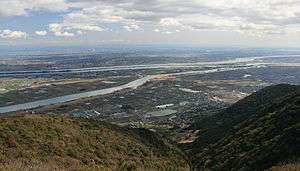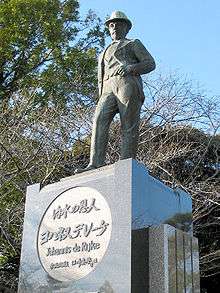1754 Horeki River Improvement Incident
| 1754 Horeki River Improvement Incident | |
|---|---|
| Location | Nobi Plain, Gifu Prefecture, Japan |
| Date | 1754 - 1755 |
| Target | Satsuma samurais |
Attack type | Harassment in forced river improvement order by the bakufu |
| Deaths | 85 persons were considered Satsuma samurais dead |
| Victim | 85 died with disease, some with seppuku during construction |
The 1754 Horeki River Improvement Incident was an incident in which the Tokugawa Shogunate maliciously ordered the Satsuma han to carry out difficult river improvement works. Rivers which caused frequent floods included the Kiso, Nagara and Ibi Rivers near Nagoya in the Horeki age. This order ultimately resulted in 51 Satsuma samurai committing suicide, 33 persons dying from disease and the responsible karō, Hirata Yukie, committing seppuku. The river improvement project was finally completed in the Meiji era. The incident is also called the Horeki Age River Improvement Incident and the Nobi Plain River Improvement Incident.

Background
The Shimazu family in the present Kagoshima Prefecture controlled the Satsuma province for roughly four centuries prior to the beginning of the Edo period, and the establishment of the han. Towards the end of the 16th century, the Shimazu controlled nearly all of Kyushu. Despite being defeated by Toyotomi Hideyoshi in his 1587 Kyushu Campaign, and forced back to Satsuma, they remained one of the most powerful clans in Japan. In the Edo period, the Tokugawa Shogunate felt that the power of Satsuma han should be weakened.
The plain of Obi had a number of big rivers with complicated geographical features, resulting in many floods. There was a strict rule that the levee or dike of the river should be lower than the levee of the Owari han, which was one of the family of the Tokugawa Shogunate. The division of the rivers into three was originally planned by Izawa Sobei, the government head of Mino gun in 1735, but his plan was not accepted. Tokugawa Ieshige, the 9th Edo Shogun ordered the river engineering project to be done by the Satsuma han, in order to weaken them.
Summary of the project
A formal order of Tetsudai Fushin (Special order from the shogunate such as building a castle and others) was given to Satsuma han daimyo Shimazu Shigetoshi, 7th lord of the Satsuma han and 24th head of the Shimazu clan. Hirata Yukie (1704–1755) a karō (家老, an elder of the household staff), accepted the supervision of the construction project which used 947 people. The project was difficult. Fifty-one samurai and 33 others died of disease during construction. Hirata committed seppuku for the loss to the Satsuma han.
Implementation of the project
Because the order was manifestly a harassment to the Satsuma han, some samurai of the han were of the opinion that they should fight against the Shogunate, but they were overruled. The han at that time already owed 660,000 Ryo or Tael. Hirata Yukie sent a formal acceptance note on January 21, 1754. The project started on January 21. A total of 947 persons joined the project from Satsuma. He borrowed 70,000 Ryo at Osaka, and reached Mino on February 9.
Project headquarters and goals
The headquarters of the projects were named Motogoya, with an area of 4900 tsubo (about 16,200 square meters). The workers reached a peak of 2000. There were branch stations including four areas:
- Ichino Te: Aichi Prefecture Sofue cho, Shinmeitsu Wachu to Hajima city, Kuwana cho, Koyabu Wachu.
- Nino Te: Aichi Prefecture Kaibe gun Yatomi cho, Moritsu Wachu to Mie Prefecture, Kuwana gun, Kisomisaki cho, Tashiro Wachu.
- San no Te: Yasuhachigun Sumimata Wachu to Motoami Sinden Wachu.
- Yon no Te: Kaizu cho Kanamarari Wachu to Kuwana city Jizohguchi.
Harassment
The river improvement works started on February 27. The enmity of the Tokugawa shogunate was obvious because they ordered the dike destroyed three times. Samurai Nagayoshi Sobee and Otokawa Sadabuchi committed seppuku in protest. Hirata deliberately concealed this protest from the shogunate, since it might seem to betray weakness and become a cause of the extinction of the Shimazu family.
For lack of money, the food were restricted to one meal and one bowl of soup, regardless of working conditions. Neighboring peasants were forbidden to sell straw raincoats and straw sandals at a low cost, again attempting to maintain the illusion of a wealthy local economy.
In August 1754, 157 persons were infected with dysentery, of which 33 died. The project was completed on May 22, 1755. Hirata committed seppuku the following morning.
The cost was estimated to be about 400,000 Ryo or more than 30 billion yen. A loan of 220,298 Ryo was obtained from Osaka.
Completion of River Improvement in Meiji era

Flooding worsened after the completion of the river improvement works. The project was re-engineered with modern technology in the Meiji era under the direction of Johannis de Rijke(1842–1913), a Dutch civil engineer and an advisor to Japanese government.
Memorials
When the river was finally divided successfully in 1900, the Horeki Chisuishi (Horeki River Improvement Monument) was erected at the southern tip of Senbon Matsubara. In 1938, the 85 victims[1] were memorialized at Chisui Jinja, Gifu Prefecture, Kaizu shi, Kaizu Machi Aburashima.[2] InKaizu there is a Horeki Chisui Historic Spot Preservation Society which planted Kaikozu trees (Erythrina crista-galli), native to the Kagoshima Prefecture. These appear for 35 kilometres (22 mi) along the Nanno-Sekigarara Route. The route was renamed Satsuma Kaikouzu Street.
In Kagoshima, there is also a monument to the victims.
Shown here is a photograph of Ohguregawa, one of the sites of the River Improvement Incident, taken in 2008. This shows the Kiso River, separated from Nagara River and flowing into Ibi River.
Satsuma Gishiden (1977-1982), a gekiga drawn and written by Hiroshi Hirata, is a collection of fictional anecdotes revolving around the incident. The main theme of Satsuma Gishiden is the desperation and stoicism of the Satsuma samurai in the face of their ordeal.[3]

Notes
- ↑ Satsuma gishi
- ↑ previously Kaizu gun Kaizu cho
- ↑ "Satsuma Gishiden Vol. 1 TPB". Dark Horse Comics. 20 September 2006. Retrieved 23 November 2016.
External links
- 薩摩義士;Satsuma devoted samurais June 29, 2012
- 桑名市観光ガイド・海蔵寺概要Kuwana-shi, Sightseeing guide, on Kaizoji June 29, 2012